A New Integrated Approach for Municipal Landfill Siting Based on Urban Physical Growth Prediction: A Case Study Mashhad Metropolis in Iran
Abstract
1. Introduction
2. Materials and Methods
2.1. Study Area
2.2. Methodology and Data
2.3. Identification of the Criteria
2.3.1. Environmental Criteria
2.3.2. Economic Criteria
2.4. Spatial Analysis and AHP-WLC
2.5. Simulation of Urban Growth
2.6. The SVM Algorithm
2.7. Urban Growth Estimation
2.8. Classification of the Achieved Suitable Map
3. Results
4. Discussion
5. Conclusions
Author Contributions
Funding
Acknowledgments
Conflicts of Interest
References
- Leao, S.; Bishop, I.; Evans, D. Assessing the demand of solid waste disposal in urban region by urban dynamics modelling in a GIS environment. Resour. Conserv. Recycl. 2001, 33, 289–313. [Google Scholar] [CrossRef]
- Barakat, A.; Hilali, A.; El Baghdadi, M.; Touhami, F. Landfill site selection with GIS-based multi-criteria evaluation technique. A case study in Béni Mellal-Khouribga Region, Morocco. Environ. Earth Sci. 2017, 76, 413. [Google Scholar] [CrossRef]
- Yeung, I.M.; Chung, W. Factors that affect the willingness of residents to pay for solid waste management in Hong Kong. Environ. Sci. Pollut. Res. 2018, 25, 7504–7517. [Google Scholar] [CrossRef] [PubMed]
- Leao, S.; Bishop, I.; Evans, D. Spatial–temporal model for demand and allocation of waste landfills in growing urban regions. Comput. Environ. Urban Syst. 2004, 28, 353–385. [Google Scholar] [CrossRef]
- Mikkelsen, P.; Häfliger, M.; Ochs, M.; Jacobsen, P.; Tjell, J.; Boller, M. Pollution of soil and groundwater from infiltration of highly contaminated stormwater—A case study. Water Sci. Technol. 1997, 36, 325–330. [Google Scholar] [CrossRef]
- Hoang, G.M.; Fujiwara, T.; Phu, T.S.P.; Nguyen, L.D. Sustainable solid waste management system using multi-objective decision-making model: A method for maximizing social acceptance in Hoi An city, Vietnam. Environ. Sci. Pollut. Res. 2019, 26, 34137–34147. [Google Scholar] [CrossRef] [PubMed]
- Downey, L.; Van Willigen, M. Environmental stressors: The mental health impacts of living near industrial activity. J. Health Soc. Behav. 2005, 46, 289–305. [Google Scholar] [CrossRef] [PubMed]
- Kjeldsen, P.; Barlaz, M.A.; Rooker, A.P.; Baun, A.; Ledin, A.; Christensen, T.H. Present and long-term composition of MSW landfill leachate: A review. Crit. Rev. Environ. Sci. Technol. 2002, 32, 297–336. [Google Scholar] [CrossRef]
- Wang, Y.; Li, J.; An, D.; Xi, B.; Tang, J.; Wang, Y.; Yang, Y. Site selection for municipal solid waste landfill considering environmental health risks. Resour. Conserv. Recycl. 2018, 138, 40–46. [Google Scholar] [CrossRef]
- Palmiotto, M.; Fattore, E.; Paiano, V.; Celeste, G.; Colombo, A.; Davoli, E. Influence of a municipal solid waste landfill in the surrounding environment: Toxicological risk and odor nuisance effects. Environ. Int. 2014, 68, 16–24. [Google Scholar] [CrossRef] [PubMed]
- Kahhat, R.; Williams, E. Materials flow analysis of e-waste: Domestic flows and exports of used computers from the United States. Resour. Conserv. Recycl. 2012, 67, 67–74. [Google Scholar] [CrossRef]
- Eskandari, M.; Homaee, M.; Mahmodi, S. An integrated multi criteria approach for landfill siting in a conflicting environmental, economical and socio-cultural area. Waste Manag. 2012, 32, 1528–1538. [Google Scholar] [CrossRef]
- Karimi, H.; Amiri, S.; Huang, J.; Karimi, A. Integrating GIS and multi-criteria decision analysis for landfill site selection, case study: Javanrood County in Iran. Int. J. Environ. Sci. Technol. 2019, 16, 7305–7318. [Google Scholar] [CrossRef]
- Effat, H.A.; Hegazy, M.N. Mapping potential landfill sites for North Sinai cities using spatial multicriteria evaluation. Egypt. J. Remote Sens. Space Sci. 2012, 15, 125–133. [Google Scholar] [CrossRef]
- Kontos, T.D.; Komilis, D.P.; Halvadakis, C.P. Siting MSW landfills with a spatial multiple criteria analysis methodology. Waste Manag. 2005, 25, 818–832. [Google Scholar] [CrossRef]
- Adeyemi, G.A.; Markus, M.; Gbolahan, O.; Edeki, S. Landfill site selection in ado-odo ota lga using geographic information systemS. Int. J. Civ. Eng. Technol. 2018, 9, 1434–1445. [Google Scholar]
- Shorabeh, S.N.; Firozjaei, M.K.; Nematollahi, O.; Firozjaei, H.K.; Jelokhani-Niaraki, M. A risk-based multi-criteria spatial decision analysis for solar power plant site selection in different climates: A case study in Iran. Renew. Energy 2019, 143, 958–973. [Google Scholar] [CrossRef]
- Firozjaei, M.K.; Nematollahi, O.; Mijani, N.; Shorabeh, S.N.; Firozjaei, H.K.; Toomanian, A. An integrated GIS-based Ordered Weighted Averaging analysis for solar energy evaluation in Iran: Current conditions and future planning. Renew. Energy 2019, 136, 1130–1146. [Google Scholar] [CrossRef]
- Nadizadeh Shorabeh, S.; Neisany Samany, N.; Abdali, Y. Mapping the potential of solar power plants based on the concept of risk Case study: Razavi Khorasan Province. Sci. Res. Q. Geogr. Data 2019, 28, 129–147. (In Persian) [Google Scholar]
- Torabi-Kaveh, M.; Babazadeh, R.; Mohammadi, S.; Zaresefat, M. Landfill site selection using combination of GIS and fuzzy AHP, a case study: Iranshahr, Iran. Waste Manag. Res. 2016, 34, 438–448. [Google Scholar] [CrossRef]
- Ding, H.; Shi, W. Land-use/land-cover change and its influence on surface temperature: A case study in Beijing City. Int. J. Remote Sens. 2013, 34, 5503–5517. [Google Scholar] [CrossRef]
- Zabihi, H.; Alizadeh, M.; Kibet Langat, P.; Karami, M.; Shahabi, H.; Ahmad, A.; Nor Said, M.; Lee, S. GIS Multi-Criteria Analysis by Ordered Weighted Averaging (OWA): Toward an integrated citrus management strategy. Sustainability 2019, 11, 1009. [Google Scholar] [CrossRef]
- Tayyebi, A.; Shafizadeh-Moghadam, H.; Tayyebi, A.H. Analyzing long-term spatio-temporal patterns of land surface temperature in response to rapid urbanization in the mega-city of Tehran. Land Use Policy 2018, 71, 459–469. [Google Scholar] [CrossRef]
- Gorsevski, P.V.; Donevska, K.R.; Mitrovski, C.D.; Frizado, J.P. Integrating multi-criteria evaluation techniques with geographic information systems for landfill site selection: A case study using ordered weighted average. Waste Manag. 2012, 32, 287–296. [Google Scholar] [CrossRef] [PubMed]
- Mir, M.A.; Ghazvinei, P.T.; Sulaiman, N.; Basri, N.E.A.; Saheri, S.; Mahmood, N.; Jahan, A.; Begum, R.A.; Aghamohammadi, N. Application of TOPSIS and VIKOR improved versions in a multi criteria decision analysis to develop an optimized municipal solid waste management model. J. Environ. Manag. 2016, 166, 109–115. [Google Scholar]
- Rahmat, Z.G.; Niri, M.V.; Alavi, N.; Goudarzi, G.; Babaei, A.A.; Baboli, Z.; Hosseinzadeh, M. Landfill site selection using GIS and AHP: A case study: Behbahan, Iran. KSCE J. Civ. Eng. 2017, 21, 111–118. [Google Scholar] [CrossRef]
- Ahmad, S.Z.; Ahamad, M.S.S.; Yusoff, M.S.; Abujayyab, S.K. Enhanced Fuzzy-OWA model for municipal solid waste landfill site selection. In Proceedings of the AIP Conference Proceedings, Bydgoszcz, Poland, 9–11 May 2017; p. 040004. [Google Scholar]
- Santhosh, L.; Sivakumar Babu, G. Landfill site selection based on reliability concepts using the DRASTIC method and AHP integrated with GIS–a case study of Bengaluru city, India. Georisk Assess. Manag. Risk Eng. Syst. Geohazards 2018, 12, 234–252. [Google Scholar] [CrossRef]
- Aksoy, E.; San, B.T. Geographical information systems (GIS) and multi-criteria decision analysis (MCDA) integration for sustainable landfill site selection considering dynamic data source. Bull. Eng. Geol. Environ. 2019, 78, 779–791. [Google Scholar] [CrossRef]
- Feyzi, S.; Khanmohammadi, M.; Abedinzadeh, N.; Aalipour, M. Multi-criteria decision analysis FANP based on GIS for siting municipal solid waste incineration power plant in the north of Iran. Sustain. Cities Soc. 2019, 47, 101513. [Google Scholar] [CrossRef]
- Kamdar, I.; Ali, S.; Bennui, A.; Techato, K.; Jutidamrongphan, W. Municipal solid waste landfill siting using an integrated GIS-AHP approach: A case study from Songkhla, Thailand. Resour. Conserv. Recycl. 2019, 149, 220–235. [Google Scholar] [CrossRef]
- Rahimi, S.; Hafezalkotob, A.; Monavari, S.M.; Hafezalkotob, A.; Rahimi, R. Sustainable landfill site selection for municipal solid waste based on a hybrid decision-making approach: Fuzzy group BWM-MULTIMOORA-GIS. J. Clean. Prod. 2020, 248, 119186. [Google Scholar] [CrossRef]
- Njoku, P.O.; Edokpayi, J.N.; Odiyo, J.O. Health and environmental risks of residents living close to a landfill: A case study of Thohoyandou Landfill, Limpopo Province, South Africa. Int. J. Environ. Res. Public Health 2019, 16, 2125. [Google Scholar] [CrossRef] [PubMed]
- Bridges, O.; Bridges, J.W.; Potter, J.F. A generic comparison of the airborne risks to human health from landfill and incinerator disposal of municipal solid waste. Environmentalist 2000, 20, 325–334. [Google Scholar] [CrossRef]
- Sankoh, F.P.; Yan, X.; Tran, Q. Environmental and health impact of solid waste disposal in developing cities: A case study of granville brook dumpsite, Freetown, Sierra Leone. J. Environ. Prot. 2013, 4, 665–670. [Google Scholar] [CrossRef]
- Brender, J.D.; Maantay, J.A.; Chakraborty, J. Residential proximity to environmental hazards and adverse health outcomes. Am. J. Public Health 2011, 101, S37–S52. [Google Scholar] [CrossRef]
- Vrijheid, M. Health effects of residence near hazardous waste landfill sites: A review of epidemiologic literature. Environ. Health Perspect. 2000, 108, 101–112. [Google Scholar]
- Wang, G.; Qin, L.; Li, G.; Chen, L. Landfill site selection using spatial information technologies and AHP: A case study in Beijing, China. J. Environ. Manag. 2009, 90, 2414–2421. [Google Scholar] [CrossRef] [PubMed]
- Mahini, A.S.; Gholamalifard, M. Siting MSW landfills with a weighted linear combination methodology in a GIS environment. Int. J. Environ. Sci. Technol. 2006, 3, 435–445. [Google Scholar] [CrossRef]
- Akbari, V.; Rajabi, M.; Chavoshi, S.; Shams, R. Landfill site selection by combining GIS and fuzzy multi criteria decision analysis, case study: Bandar Abbas, Iran. World Appl. Sci. J. 2008, 3, 39–47. [Google Scholar]
- Şener, Ş.; Şener, E.; Nas, B.; Karagüzel, R. Combining AHP with GIS for landfill site selection: A case study in the Lake Beyşehir catchment area (Konya, Turkey). Waste Manag. 2010, 30, 2037–2046. [Google Scholar] [CrossRef]
- Arkoc, O. Municipal solid waste landfill site selection using geographical information systems: A case study from Çorlu, Turkey. Arab. J. Geosci. 2014, 7, 4975–4985. [Google Scholar] [CrossRef]
- Beskese, A.; Demir, H.H.; Ozcan, H.K.; Okten, H.E. Landfill site selection using fuzzy AHP and fuzzy TOPSIS: A case study for Istanbul. Environ. Earth Sci. 2015, 73, 3513–3521. [Google Scholar] [CrossRef]
- Al-Anbari, M.; Thameer, M.; Al-Ansari, N. Landfill Site Selection by Weighted Overlay Technique: Case Study of Al-Kufa, Iraq. Sustainability 2018, 10, 999. [Google Scholar] [CrossRef]
- Alam, S.; Kolekar, K.; Hazra, T.; Chakrabarty, S. Selection of Suitable Landfill Site for Municipal Solid Waste Disposal: A Fuzzy Logic Approach. In Waste Management and Resource Efficiency; Springer: Berlin/Heidelberg, Germany, 2019; pp. 109–129. [Google Scholar]
- Aydi, A.; Zairi, M.; Dhia, H.B. Minimization of environmental risk of landfill site using fuzzy logic, analytical hierarchy process, and weighted linear combination methodology in a geographic information system environment. Environ. Earth Sci. 2013, 68, 1375–1389. [Google Scholar] [CrossRef]
- Vasiljević, T.Z.; Srdjević, Z.; Bajčetić, R.; Miloradov, M.V. GIS and the analytic hierarchy process for regional landfill site selection in transitional countries: A case study from Serbia. Environ. Manag. 2012, 49, 445–458. [Google Scholar] [CrossRef]
- Khan, D.; Samadder, S.R. A simplified multi-criteria evaluation model for landfill site ranking and selection based on AHP and GIS. J. Environ. Eng. Landsc. Manag. 2015, 23, 267–278. [Google Scholar] [CrossRef]
- Gnanachandrasamy, G.; Ramkumar, T.; Venkatramanan, S.; Vasudevan, S.; Chung, S.; Bagyaraj, M. Accessing groundwater quality in lower part of Nagapattinam district, Southern India: Using hydrogeochemistry and GIS interpolation techniques. Appl. Water Sci. 2015, 5, 39–55. [Google Scholar] [CrossRef]
- Kontos, T.D.; Komilis, D.P.; Halvadakis, C.P. Siting MSW landfills on Lesvos island with a GIS-based methodology. Waste Manag. Res. 2003, 21, 262–277. [Google Scholar] [CrossRef]
- Sumathi, V.; Natesan, U.; Sarkar, C. GIS-based approach for optimized siting of municipal solid waste landfill. Waste Manag. 2008, 28, 2146–2160. [Google Scholar] [CrossRef]
- Al-Hanbali, A.; Alsaaideh, B.; Kondoh, A. Using GIS-based weighted linear combination analysis and remote sensing techniques to select optimum solid waste disposal sites within Mafraq City, Jordan. J. Geogr. Inf. Syst. 2011, 3, 267. [Google Scholar] [CrossRef]
- Feizizadeh, B.; Omrani, K.; Aghdam, F.B. Fuzzy analytical hierarchical process and spatially explicit uncertainty analysis approach for multiple forest fire risk mapping. In Proceedings of the GI-Forum, Salzburg, Austria, 7–10 July 2015; pp. 72–80. [Google Scholar]
- Şener, B.; Süzen, M.L.; Doyuran, V. Landfill site selection by using geographic information systems. Environ. Geol. 2006, 49, 376–388. [Google Scholar] [CrossRef]
- Allen, B.; Caetano, P.; Costa, C.; Cummins, V.; Donnelly, J.; Koukoulas, S.; O’donnell, V.; Robalo, C.; Vendas, D. A landfill site selection process incorporating GIS modelling. In Proceedings of the Ninth International Waste Management and Landfill, Sardinia, Italy, 1–6 October 2003. [Google Scholar]
- Alexakis, D.D.; Sarris, A. Integrated GIS and remote sensing analysis for landfill sitting in Western Crete, Greece. Environ. Earth Sci. 2014, 72, 467–482. [Google Scholar] [CrossRef]
- Firozjaei, M.K.; Kiavarz, M.; Alavipanah, S.K.; Lakes, T.; Qureshi, S. Monitoring and forecasting heat island intensity through multi-temporal image analysis and cellular automata-Markov chain modelling: A case of Babol city, Iran. Ecol. Indic. 2018, 91, 155–170. [Google Scholar] [CrossRef]
- Vlassova, L.; Perez-Cabello, F.; Nieto, H.; Martín, P.; Riaño, D.; De La Riva, J. Assessment of methods for land surface temperature retrieval from Landsat-5 TM images applicable to multiscale tree-grass ecosystem modeling. Remote Sens. 2014, 6, 4345–4368. [Google Scholar] [CrossRef]
- Nadizadeh Shorabeh, S.; Hamzeh, S.; Zanganeh Shahraki, S.; Firozjaei, M.K.; Jokar Arsanjani, J. Modelling the intensity of surface urban heat island and predicting the emerging patterns: Landsat multi-temporal images and Tehran as case study. Int. J. Remote Sens. 2020, 41, 7400–7426. [Google Scholar] [CrossRef]
- Lin, H.-Y.; Kao, J.-J. A vector-based spatial model for landfill siting. J. Hazard. Mater. 1998, 58, 3–14. [Google Scholar] [CrossRef]
- Nadizadeh, S.S.; Neysani, S.N.; Jelokhani, N.M. Determination of optimum areas for the landfill with emphasis on the urban expansion trend based on the combination of the Analytical Hierarchy Process and the Ordered Weighted Averaging model. J. Nat. Environ. 2018, 70, 949–969. (In Persian) [Google Scholar]
- Şener, Ş.; Sener, E.; Karagüzel, R. Solid waste disposal site selection with GIS and AHP methodology: A case study in Senirkent–Uluborlu (Isparta) Basin, Turkey. Environ. Monit. Assess. 2011, 173, 533–554. [Google Scholar] [CrossRef] [PubMed]
- Kahraman, C.; Cebi, S.; Onar, S.C.; Oztaysi, B. A novel trapezoidal intuitionistic fuzzy information axiom approach: An application to multicriteria landfill site selection. Eng. Appl. Artif. Intell. 2018, 67, 157–172. [Google Scholar] [CrossRef]
- Karasan, A.; Ilbahar, E.; Kahraman, C. A novel pythagorean fuzzy AHP and its application to landfill site selection problem. Soft Comput. 2019, 23, 10953–10968. [Google Scholar] [CrossRef]
- Saaty, T.L. The analytical hierarchy process, planning, priority. In Resource Allocation; RWS Publications: Pittsburgh, PA, USA, 1980. [Google Scholar]
- Saaty, T.L. Axiomatic foundation of the analytic hierarchy process. Manag. Sci. 1986, 32, 841–855. [Google Scholar] [CrossRef]
- Saaty, T.L. Decision making with the analytic hierarchy process. Int. J. Serv. Sci. 2008, 1, 83–98. [Google Scholar] [CrossRef]
- Saaty, T.L.; Vargas, L.G. Prediction, Projection, and Forecasting: Applications of the Analytic Hierarchy Process in Economics, Finance, Politics, Games, and Sports; Kluwer Academic Publishers: Dordrecht, The Netherlands, 1991. [Google Scholar]
- Malczewski, J. Ordered weighted averaging with fuzzy quantifiers: GIS-based multicriteria evaluation for land-use suitability analysis. Int. J. Appl. Earth Obs. Geoinf. 2006, 8, 270–277. [Google Scholar] [CrossRef]
- Boloorani, A.D.; Kazemi, Y.; Sadeghi, A.; Shorabeh, S.N.; Argany, M. Identification of dust sources using long term satellite and climatic data: A case study of Tigris and Euphrates basin. Atmos. Environ. 2020, 224, 117299. [Google Scholar] [CrossRef]
- Dadras, M.; Shafri, H.Z.; Ahmad, N.; Pradhan, B.; Safarpour, S. Spatio-temporal analysis of urban growth from remote sensing data in Bandar Abbas city, Iran. Egypt. J. Remote Sens. Space Sci. 2015, 18, 35–52. [Google Scholar] [CrossRef]
- Firozjaei, M.K.; Sedighi, A.; Argany, M.; Jelokhani-Niaraki, M.; Arsanjani, J.J. A geographical direction-based approach for capturing the local variation of urban expansion in the application of CA-Markov model. Cities 2019, 93, 120–135. [Google Scholar] [CrossRef]
- Karimi Firuzjaei, M.; Kiavarz Moghadam, M.; Mijani, N.; Alavi Panah, S. Quantifying the degree-of-freedom, degree-of-sprawl and degree-of-goodness of urban growth tehran and factors affecting it using remote sensing and statistical analyzes. J. Geomat. Sci. Technol. 2018, 7, 89–107. [Google Scholar]
- El-Magd, I.A.; Hasan, A.; El Sayed, A. A Century of Monitoring Urban Growth in Menofya Governorate, Egypt, Using Remote Sensing and Geographic Information Analysis. J. Geogr. Inf. Syst. 2015, 7, 402. [Google Scholar] [CrossRef]
- Mountrakis, G.; Im, J.; Ogole, C. Support vector machines in remote sensing: A review. ISPRS J. Photogramm. Remote Sens. 2011, 66, 247–259. [Google Scholar] [CrossRef]
- Kavzoglu, T.; Colkesen, I. A kernel functions analysis for support vector machines for land cover classification. Int. J. Appl. Earth Obs. Geoinf. 2009, 11, 352–359. [Google Scholar] [CrossRef]
- Rumpf, T.; Mahlein, A.-K.; Steiner, U.; Oerke, E.-C.; Dehne, H.-W.; Plümer, L. Early detection and classification of plant diseases with support vector machines based on hyperspectral reflectance. Comput. Electron. Agric. 2010, 74, 91–99. [Google Scholar] [CrossRef]
- Jiang, G.; Zhang, F.; Kong, X. Determining conversion direction of rural residential land consolidation in Beijing mountainous areas. Trans. Chin. Soc. Agric. Eng. 2009, 25, 214–221. [Google Scholar]
- Arsanjani, J.J.; Kainz, W.; Mousivand, A.J. Tracking dynamic land-use change using spatially explicit Markov Chain based on cellular automata: The case of Tehran. Int. J. Image Data Fusion 2011, 2, 329–345. [Google Scholar] [CrossRef]
- Sang, L.; Zhang, C.; Yang, J.; Zhu, D.; Yun, W. Simulation of land use spatial pattern of towns and villages based on CA–Markov model. Math. Comput. Model. 2011, 54, 938–943. [Google Scholar] [CrossRef]
- Walawender, J.P.; Szymanowski, M.; Hajto, M.J.; Bokwa, A. Land surface temperature patterns in the urban agglomeration of Krakow (Poland) derived from Landsat-7/ETM+ data. Pure Appl. Geophys. 2014, 171, 913–940. [Google Scholar] [CrossRef]
- Yang, X.; Zheng, X.-Q.; Lv, L.-N. A spatiotemporal model of land use change based on ant colony optimization, Markov chain and cellular automata. Ecol. Model. 2012, 233, 11–19. [Google Scholar] [CrossRef]
- Dace, E.; Bazbauers, G.; Berzina, A.; Davidsen, P.I. System dynamics model for analyzing effects of eco-design policy on packaging waste management system. Resour. Conserv. Recycl. 2014, 87, 175–190. [Google Scholar] [CrossRef]
- Hereher, M.E.; Al-Awadhi, T.; Mansour, S.A. Assessment of the optimized sanitary landfill sites in Muscat, Oman. Egypt. J. Remote Sens. Space Sci. 2020, 23, 355–362. [Google Scholar] [CrossRef]
- Eghtesadifard, M.; Afkhami, P.; Bazyar, A. An integrated approach to the selection of municipal solid waste landfills through GIS, K-Means and multi-criteria decision analysis. Environ. Res. 2020, 185, 109348. [Google Scholar] [CrossRef] [PubMed]
- Al-Aomar, R. A combined ahp-entropy method for deriving subjective and objective criteria weights. Int. J. Ind. Eng. Theory Appl. Pr. 2010, 17, 12–24. [Google Scholar]
- Belton, V.; Gear, T. On a short-coming of Saaty’s method of analytic hierarchies. Omega 1983, 11, 228–230. [Google Scholar] [CrossRef]
- Dyer, J.S. Remarks on the analytic hierarchy process. Manag. Sci. 1990, 36, 249–258. [Google Scholar] [CrossRef]
- Harker, P.T.; Vargas, L.G. The theory of ratio scale estimation: Saaty’s analytic hierarchy process. Manag. Sci. 1987, 33, 1383–1403. [Google Scholar] [CrossRef]
- Triantaphyllou, E.; Mann, S.H. Using the analytic hierarchy process for decision making in engineering applications: Some challenges. Int. J. Ind. Eng. Appl. Pract. 1995, 2, 35–44. [Google Scholar]
- Shorabeh, S.N.; Varnaseri, A.; Firozjaei, M.K.; Nickravesh, F.; Samany, N.N. Spatial modeling of areas suitable for public libraries construction by integration of GIS and multi-attribute decision making: Case study Tehran, Iran. Libr. Inf. Sci. Res. 2020, 42, 101017. [Google Scholar] [CrossRef]
- Hamad, R.; Balzter, H.; Kolo, K. Predicting land use/land cover changes using a CA-Markov model under two different scenarios. Sustainability 2018, 10, 3421. [Google Scholar] [CrossRef]
- Liu, X.; Liang, X.; Li, X.; Xu, X.; Ou, J.; Chen, Y.; Li, S.; Wang, S.; Pei, F. A future land use simulation model (FLUS) for simulating multiple land use scenarios by coupling human and natural effects. Landsc. Urban Plan. 2017, 168, 94–116. [Google Scholar] [CrossRef]
- Fu, X.; Wang, X.; Yang, Y.J. Deriving suitability factors for CA-Markov land use simulation model based on local historical data. J. Environ. Manag. 2018, 206, 10–19. [Google Scholar] [CrossRef]
- Karimi Firozjaei, M.; Sedighi, A.; Jelokhani-Niaraki, M. An urban growth simulation model based on integration of local weights and decision risk values. Trans. GIS 2020, 24, 1695–1721. [Google Scholar] [CrossRef]
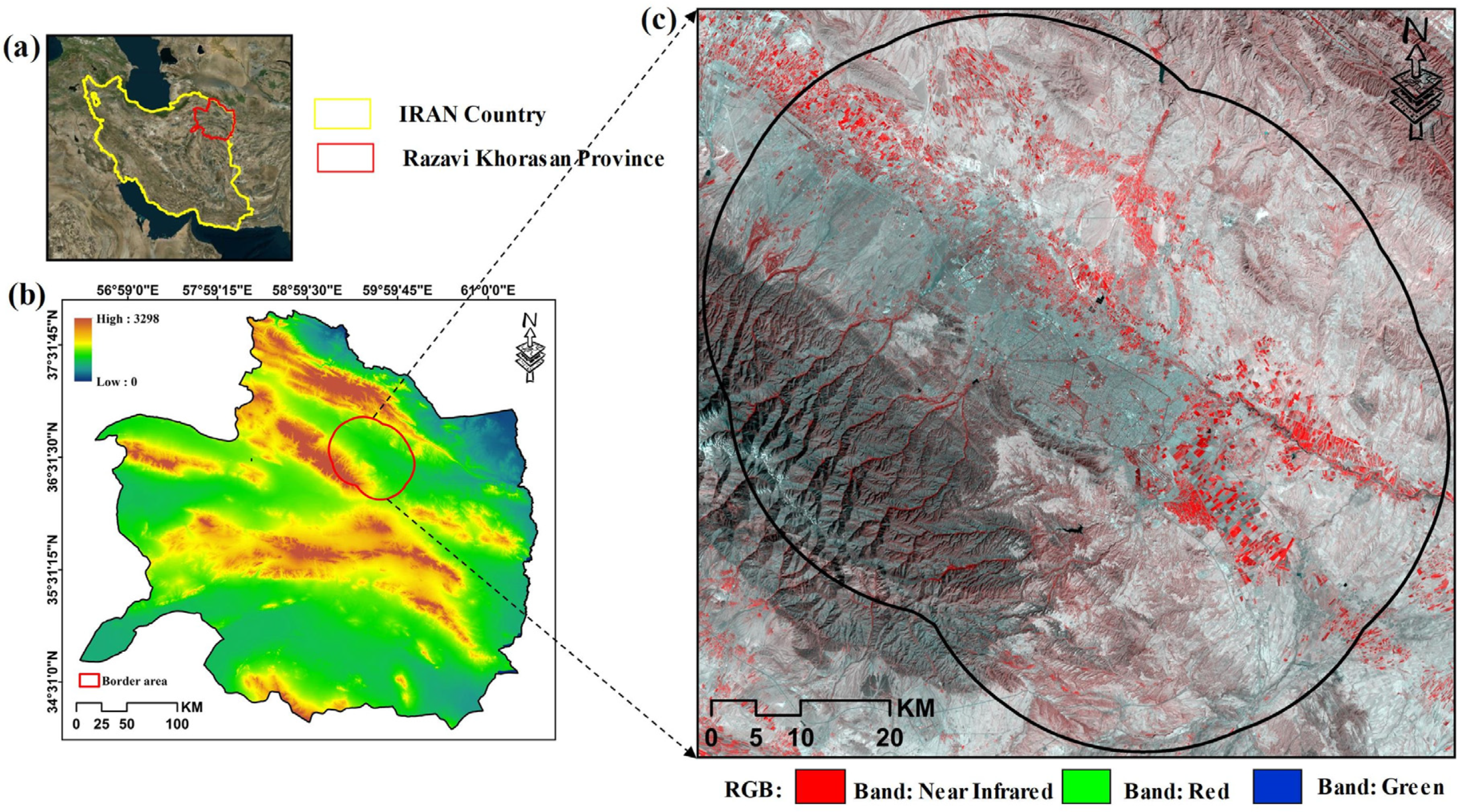
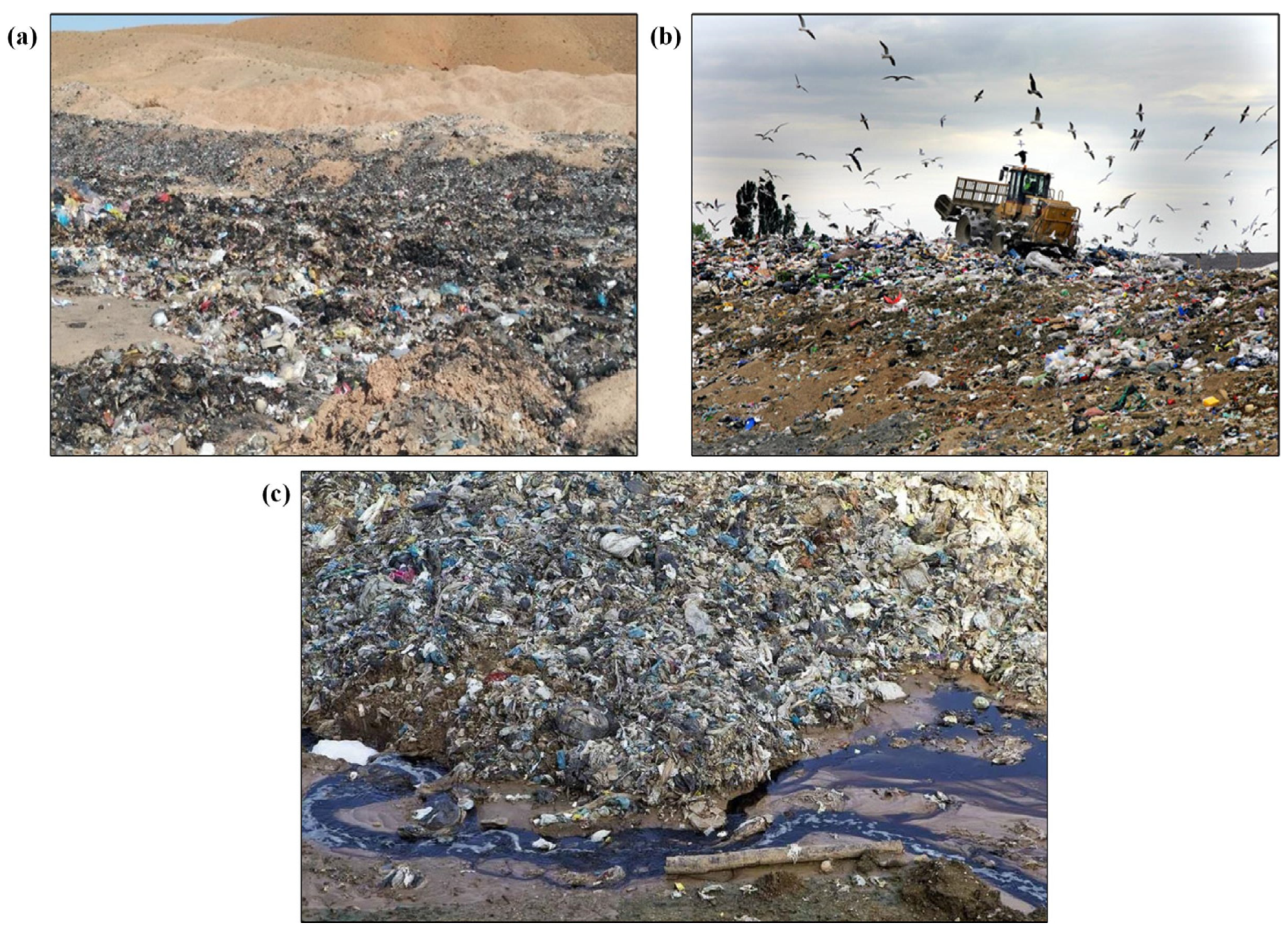

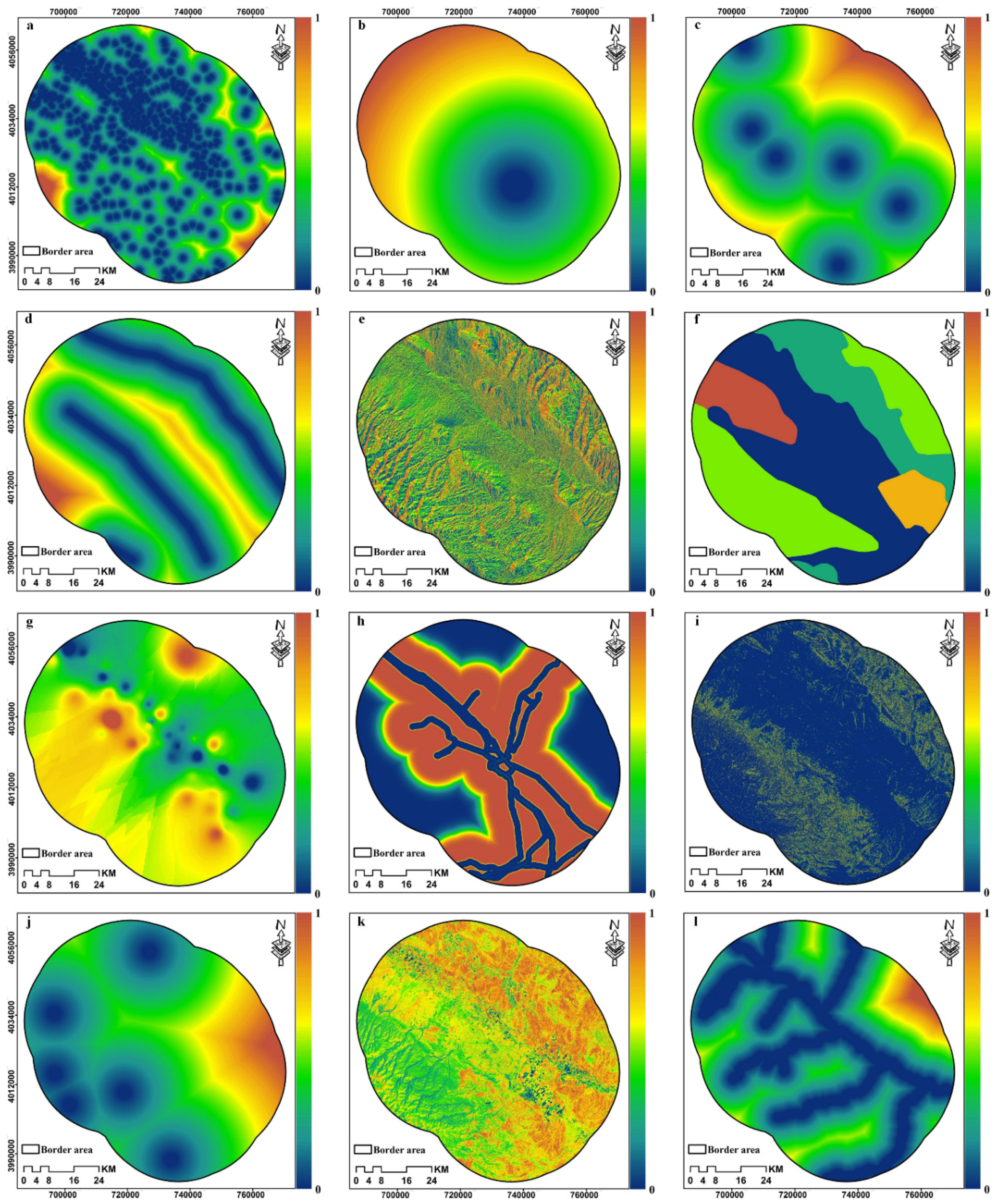
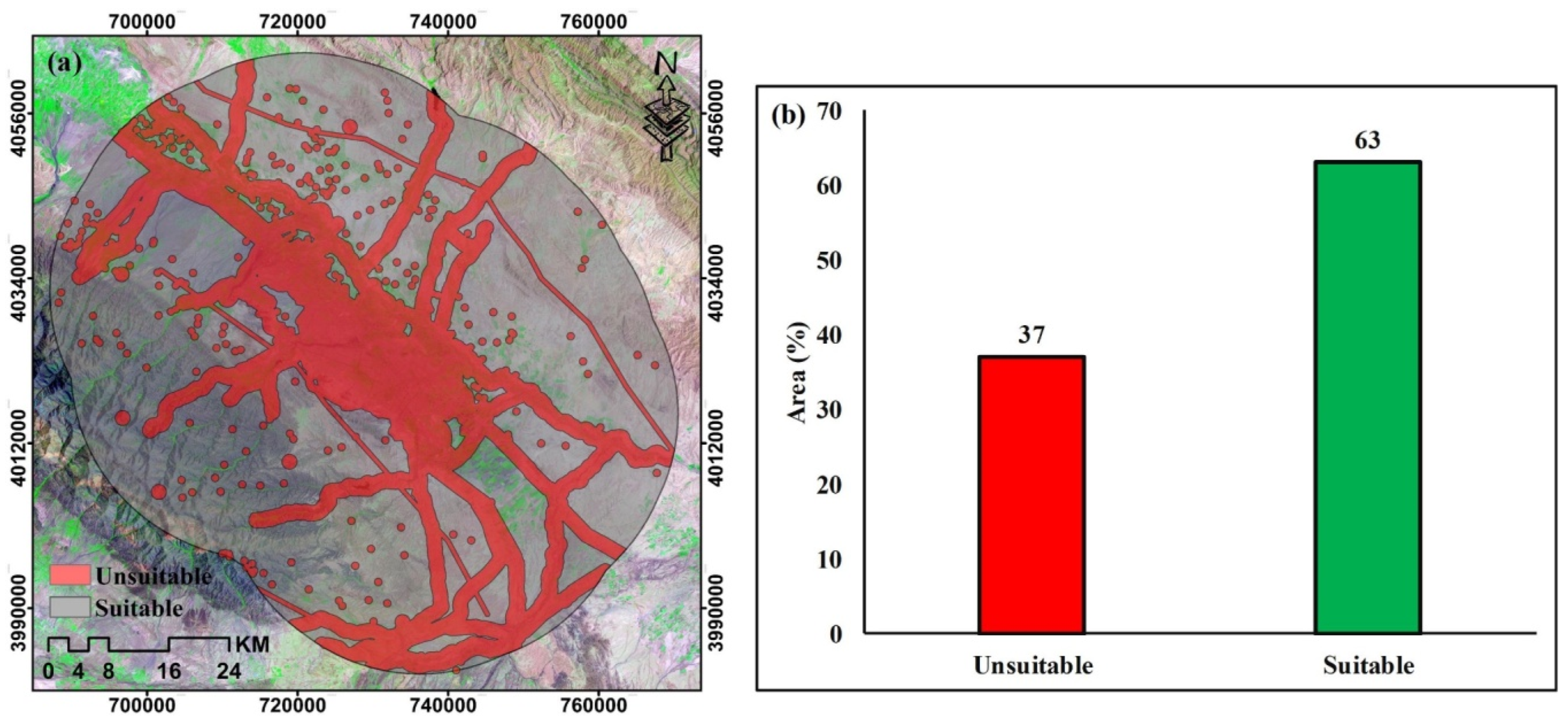
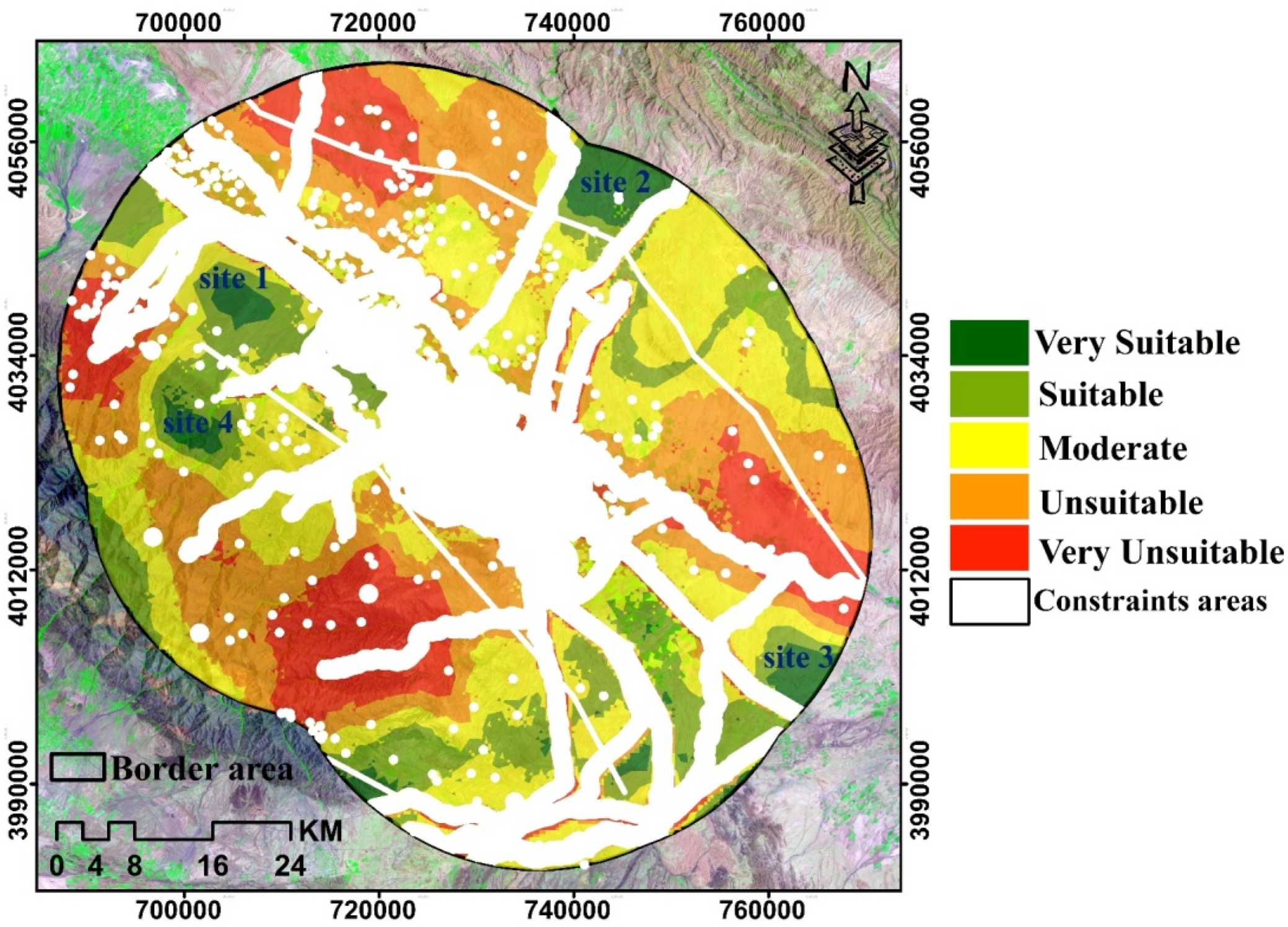
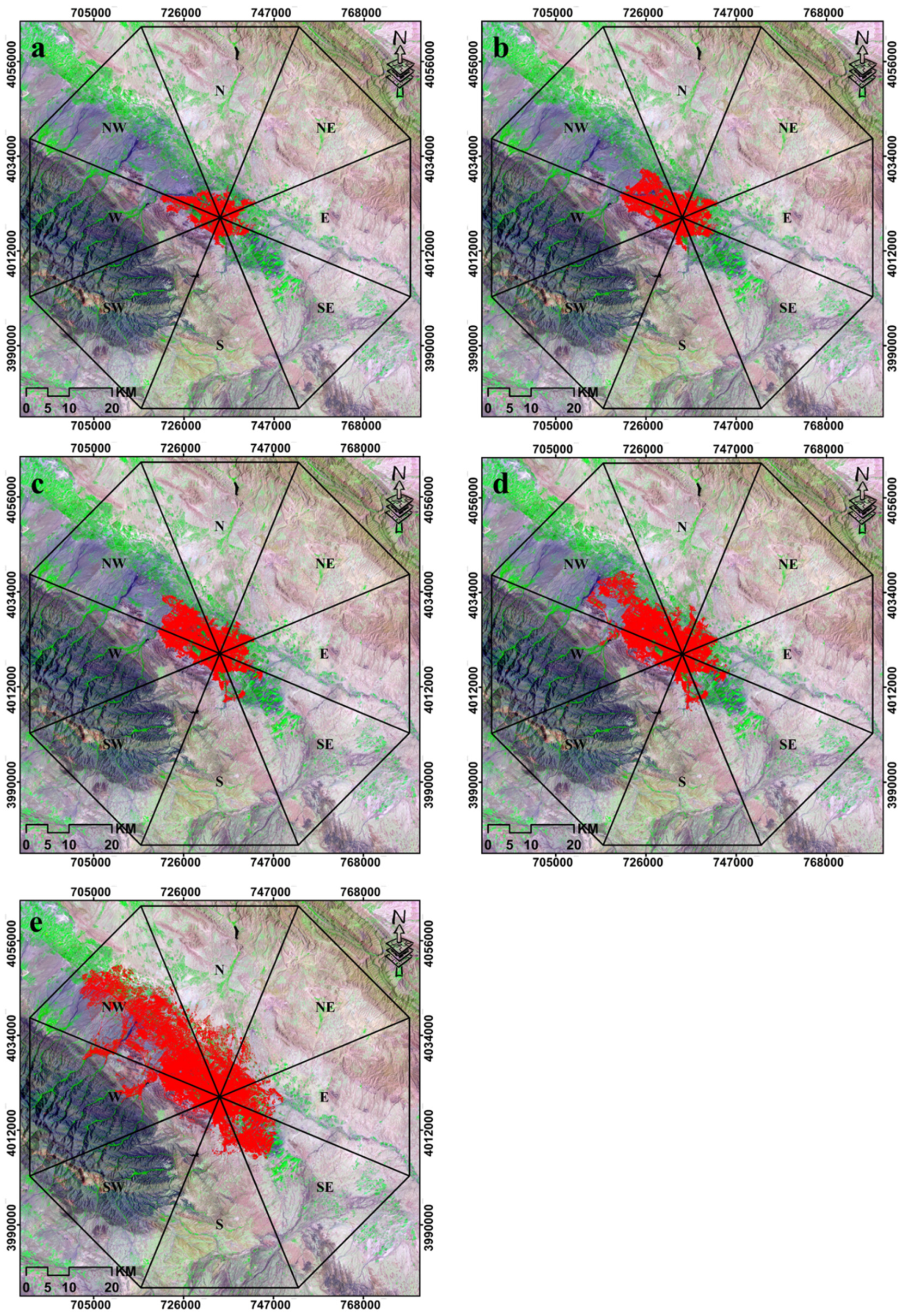
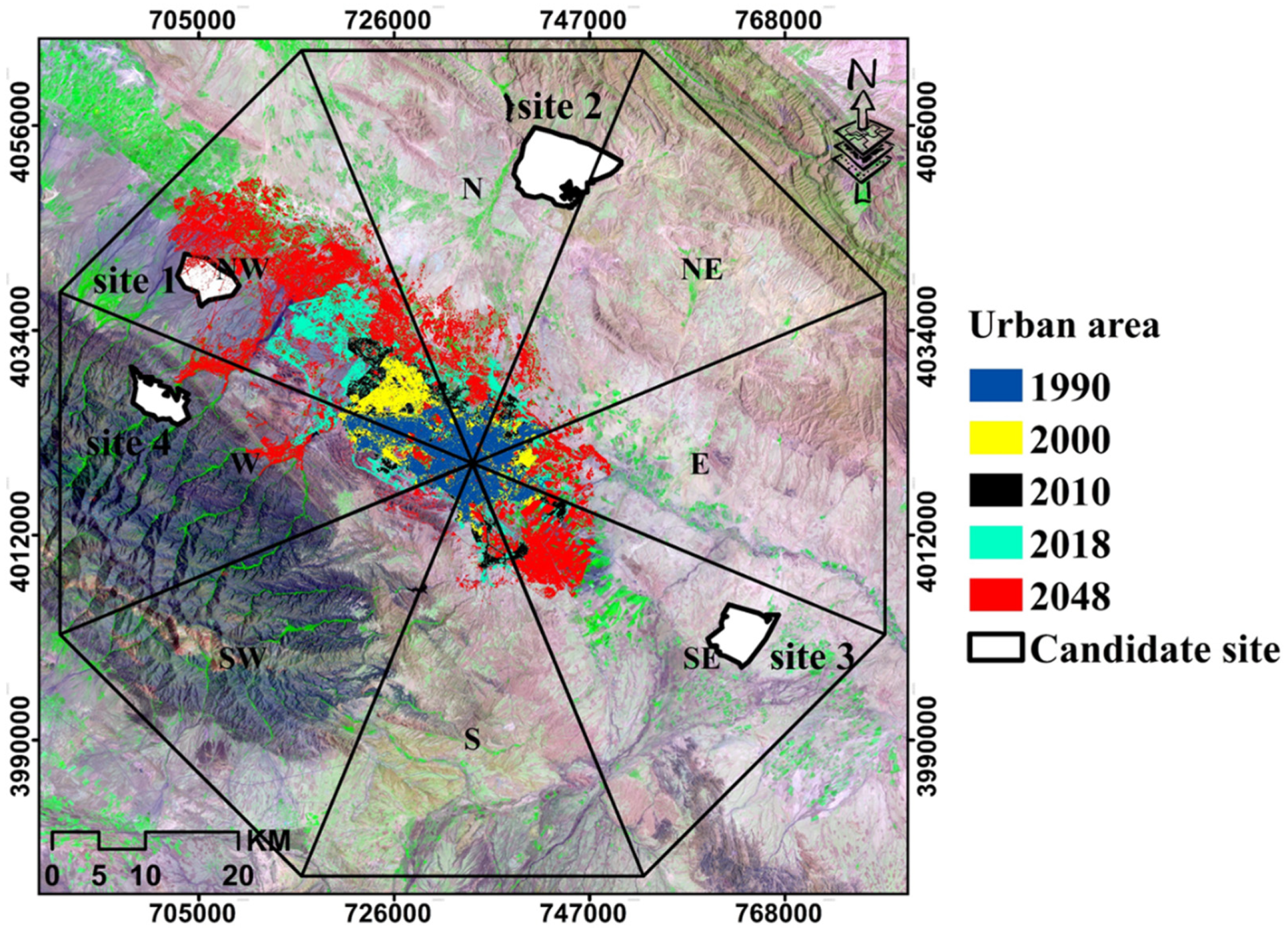
| References | Study Area | MCDA Method | Criteria Weighting | Advantages and Disadvantages of the Method |
|---|---|---|---|---|
| Tayyebi et al. [23] | Zanjan, Iran | Dempster–Shafer | Expert interviews | Advantages: uncertainty supported, no bias in decision-making. Disadvantages: time-consuming, hard to convince decision-making. |
| Gorsevski et al. [24] | Polog Region, Macedonia | AHP-OWA | Pairwise comparison of criteria | Advantages: flexible, intuitive and checks inconsistencies, considers risk in decision-making. Disadvantages: uncertainty—not supported, measurement error can cause significant problems. |
| Torabi-Kaveh et al. [20] | Iranshahr, Iran | FAHP | Based on the authors’ expertise | Advantages: similar to human reasoning, high precision, based on the linguistic model. Disadvantages: the lower speed and also longer run time of system, lack of real-time response, restricted number of usage of input variables. |
| Mir et al. [25] | Selangor, Malaysia | TOPSIS and VIKOR | Direct assignments of criteria weights based on the common sense of the author | Advantages: ability to use real and experimental data, works with fundamental rankings and makes full use of allocated information. Disadvantages: since it uses Euclidian distances, it does not differentiate between negative and positive values, lacks consideration of interactions among criteria. |
| Rahmat et al. [26] | Behbahan, Iran | AHP | Pairwise comparison of criteria | Advantages: it is adaptable, intuitive and verifiable for inconsistencies, computationally non-demanding, deals with both quantitative and qualitative criteria. Disadvantages: irregularities in the ranking, additive aggregation is used, more pairwise comparisons are needed, uncertainty—not supported. |
| Barakat et al. [2] | Béni Mellal-Khouribga Region, Morocco | AHP | Pairwise comparison of criteria | Advantages: it is adaptable, intuitive and verifiable for inconsistencies, computationally non-demanding, deals with both quantitative and qualitative criteria. Disadvantages: irregularities in the ranking, additive aggregation is used, more pairwise comparisons are needed, uncertainty—not supported. |
| Ahmad et al. [27] | Seberang Perai, Malaysia | Fuzzy-OWA | No explanation about who assigns weights | Advantages: in addition to considering the weight of the criteria, it also considers the ordered weights, considers risk in decision-making, prepares different scenarios for decision-making. Disadvantages: time-consuming, determining the type of ordered weights is complicated. |
| Santhosh and Sivakumar Babu [28] | Bengaluru, India | DRASTIC method and AHP | Direct assignments of criteria weights | Advantages: scalability, simplicity, absolute efficiency cannot be measured. Disadvantages: requires accurate inputs, uncertainty not supported, time-consuming. |
| Aksoy and San [29] | Antalya, Turkey | AHP-WLC | Pairwise comparison of criteria | Advantages: scalability, simplicity. Disadvantages: uncertainty not supported. |
| Feyzi et al. [30] | Anzali, Iran | FANP | Pairwise comparison of criteria | Advantages: uncertainty supported, independence among elements is not required, the prediction is accurate because priorities are improved by feedback. Disadvantages: time-consuming, hard to convince decision-making. |
| Kamdar et al. [31] | Songkhla, Thailand | AHP | Expert interviews | Advantages: it is adaptable, intuitive and verifiable for inconsistencies, computationally non-demanding, deals with both quantitative and qualitative criteria. Disadvantages: irregularities in the ranking, additive aggregation is used, more pairwise comparisons are needed, uncertainty—not supported. |
| Rahimi et al. [32] | Mahallat, Iran | Fuzzy-BWM | Based on the authors’ expertise | Advantages: only integers are used, making it much easier to use, uncertainty supported, requires fewer Pairwise comparisons. Disadvantages: time-consuming, Large problems can be demanding. |
| Dataset | Satellite (Sensor) | Format | Date | Resolution and Scale | Source |
|---|---|---|---|---|---|
| Satellite images | Landsat TM5 | Raster | 1990 | 30 | https://earthexplorer.usgs.gov/ (accessed on 2 October 2020) |
| Satellite images | Landsat ETM7 | Raster | 2000 | 30 | https://earthexplorer.usgs.gov/ (accessed on 2 October 2020) |
| Satellite images | Landsat TM5 | Raster | 2010 | 30 | https://earthexplorer.usgs.gov/ (accessed on 2 October 2020) |
| Satellite images | Landsat OLI8 | Raster | 2018 | 30 | https://earthexplorer.usgs.gov/ (accessed on 2 October 2020) |
| Groundwater depth | - | Excel, X, Y Coordinates | 2018 | - | https://www.wrm.i (accessed on 2 October 2020) |
| Rivers | - | Vector | 2018 | 1:25,000 | http://www.frw.org.ir (accessed on 2 October 2020) |
| Soil type | - | Vector | 2018 | 1:50,000 | http://www.frw.org.ir (accessed on 2 October 2020) |
| Geological faults | - | Vector | 2018 | 1:25,000 | http://www.gsi.ir/en (accessed on 2 October 2020) |
| Wind direction | SRTM | Raster | 2018 | 30 | https://earthexplorer.usgs.gov/ (accessed on 2 October 2020) |
| NDVI | Landsat OLI8 | Raster | 2018 | 30 | https://earthexplorer.usgs.gov/ (accessed on 2 October 2020) |
| Landslide | - | Vector | 2018 | - | http://www.frw.org.ir (accessed on 2 October 2020) |
| Airport | - | Vector | 2018 | - | http://www.ncc.org.ir (accessed on 2 October 2020) |
| City and village | - | Vector | 2018 | - | http://www.ncc.org.ir (accessed on 2 October 2020) |
| Slope | SRTM | Raster | 2018 | 30 | https://earthexplorer.usgs.gov/ (accessed on 2 October 2020) |
| Roads | - | Vector | 2018 | 1:25,000 | https://www.mrud.ir (accessed on 2 October 2020) |
| Suitable Class | Class Range |
|---|---|
| Very unsuitable | |
| Unsuitable | |
| Moderate | |
| Suitable | |
| Very suitable |
| Criteria | Weight | CR | Sub-Criteria | Weight | CR | Fuzzy Function |
|---|---|---|---|---|---|---|
| Environmental | 0.75 | 0 | Groundwater depth | 0.17 | 0.006 | Linear—increasing |
| Distance from rivers | 0.12 | Linear—increasing | ||||
| Soil texture | 0.07 | Linear—increasing | ||||
| Distance from fault | 0.03 | Linear—increasing | ||||
| Landslide | 0.05 | Linear—increasing | ||||
| Distance from airport | 0.08 | Linear—increasing | ||||
| Distance from village | 0.14 | Linear—increasing | ||||
| Distance from city | 0.13 | Linear—increasing | ||||
| Wind direction | 0.1 | Linear—increasing | ||||
| NDVI | 0.11 | Linear—decreasing | ||||
| Economic | 0.25 | Slope | 0.38 | 0.033 | Large and small | |
| Distance from roads | 0.62 | Large and small |
| Site 4 | Site 3 | Site 2 | Site 1 | Criteria |
|---|---|---|---|---|
| 90–110 | 60–80 | >130 | >100 | Groundwater depth (m) |
| 6500 | 6000 | 2000 | 5000 | Distance from rivers (m) |
| Alluvial | Salty | Latosol | Desert | Soil type |
| 6000 | 8000 | 1500 | 3000 | Distance from fault (m) |
| 4500 | 42,000 | 12,000 | 8500 | Landslide (m) |
| 35,000 | 25,000 | 36,000 | 38,500 | Distance from airport (m) |
| 4000 | 9000 | 30,000 | 6500 | Distance from city (m) |
| 900 | 5000 | 1500 | 2000 | Distance from village (m) |
| South | North | West | Northwest | Wind direction |
| 0.2–0.3 | 0.003–0.04 | 0.0006–0.008 | 0.08–0.2 | NDVI |
| <20 | <9 | <12 | <6 | Slope (%) |
| 4000 | 1500 | 1500 | 4000 | Distance from roads (m) |
| 2048 | 2018 | 2010 | 2000 | 1990 | |
|---|---|---|---|---|---|
| 4226.04 | 1744.92 | 1294.02 | 1285.11 | 825.84 | E |
| 6325.02 | 2469.78 | 1643.67 | 1197.09 | 1037.61 | N |
| 3507.75 | 2174.94 | 1764.54 | 1417.95 | 1216.44 | NE |
| 28,548 | 11,429.73 | 7176.96 | 5325.57 | 2288.25 | NW |
| 3137.04 | 2081.25 | 1603.53 | 1051.74 | 884.43 | S |
| 7412.49 | 2017.8 | 1674 | 1296.54 | 1055.88 | SE |
| 1355.13 | 765.45 | 676.26 | 656.01 | 643.86 | SW |
| 7320.78 | 4279.77 | 3352.5 | 3124.35 | 2413.62 | W |
Publisher’s Note: MDPI stays neutral with regard to jurisdictional claims in published maps and institutional affiliations. |
© 2021 by the authors. Licensee MDPI, Basel, Switzerland. This article is an open access article distributed under the terms and conditions of the Creative Commons Attribution (CC BY) license (http://creativecommons.org/licenses/by/4.0/).
Share and Cite
Qureshi, S.; Shorabeh, S.N.; Samany, N.N.; Minaei, F.; Homaee, M.; Nickravesh, F.; Firozjaei, M.K.; Arsanjani, J.J. A New Integrated Approach for Municipal Landfill Siting Based on Urban Physical Growth Prediction: A Case Study Mashhad Metropolis in Iran. Remote Sens. 2021, 13, 949. https://doi.org/10.3390/rs13050949
Qureshi S, Shorabeh SN, Samany NN, Minaei F, Homaee M, Nickravesh F, Firozjaei MK, Arsanjani JJ. A New Integrated Approach for Municipal Landfill Siting Based on Urban Physical Growth Prediction: A Case Study Mashhad Metropolis in Iran. Remote Sensing. 2021; 13(5):949. https://doi.org/10.3390/rs13050949
Chicago/Turabian StyleQureshi, Salman, Saman Nadizadeh Shorabeh, Najmeh Neysani Samany, Foad Minaei, Mehdi Homaee, Fatemeh Nickravesh, Mohammad Karimi Firozjaei, and Jamal Jokar Arsanjani. 2021. "A New Integrated Approach for Municipal Landfill Siting Based on Urban Physical Growth Prediction: A Case Study Mashhad Metropolis in Iran" Remote Sensing 13, no. 5: 949. https://doi.org/10.3390/rs13050949
APA StyleQureshi, S., Shorabeh, S. N., Samany, N. N., Minaei, F., Homaee, M., Nickravesh, F., Firozjaei, M. K., & Arsanjani, J. J. (2021). A New Integrated Approach for Municipal Landfill Siting Based on Urban Physical Growth Prediction: A Case Study Mashhad Metropolis in Iran. Remote Sensing, 13(5), 949. https://doi.org/10.3390/rs13050949









